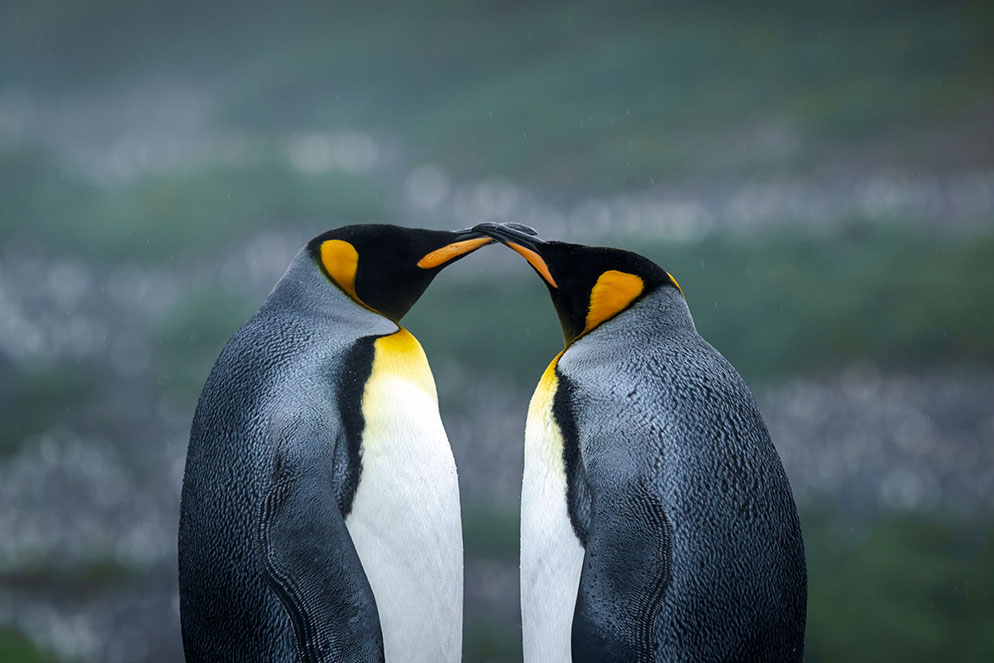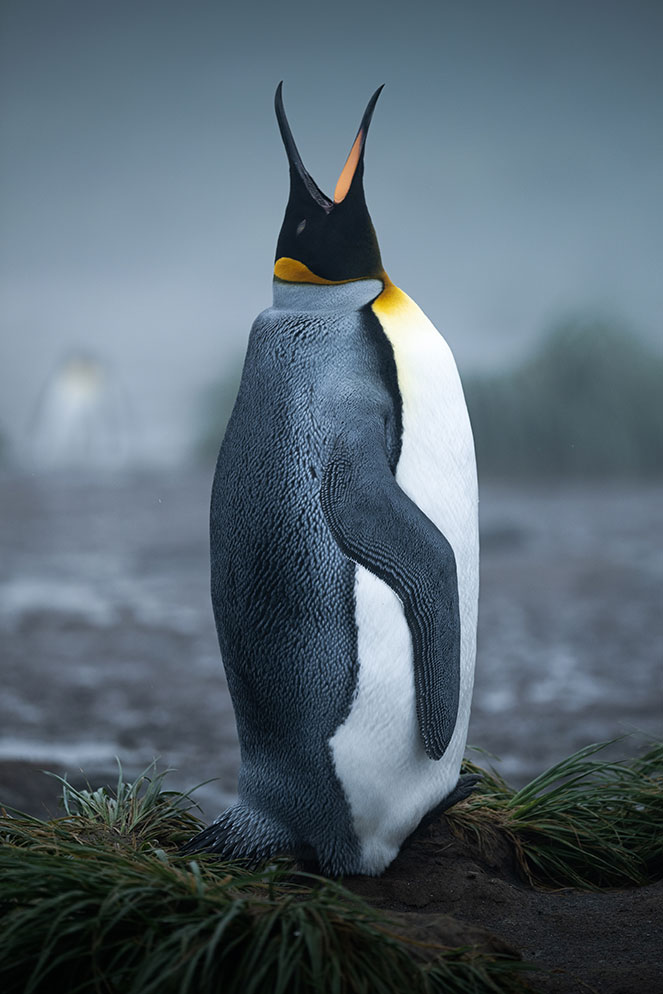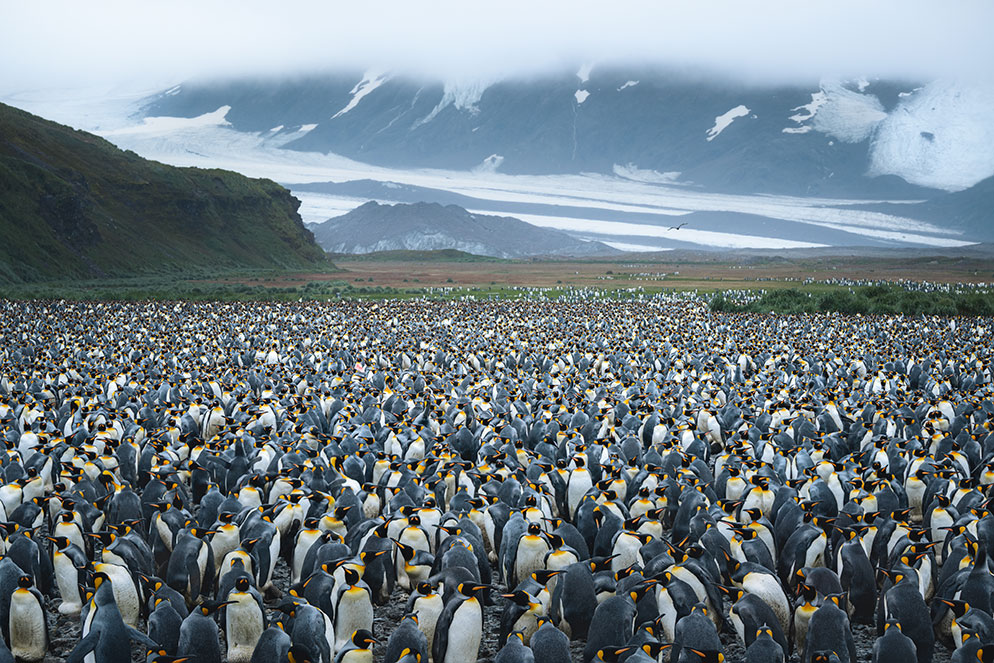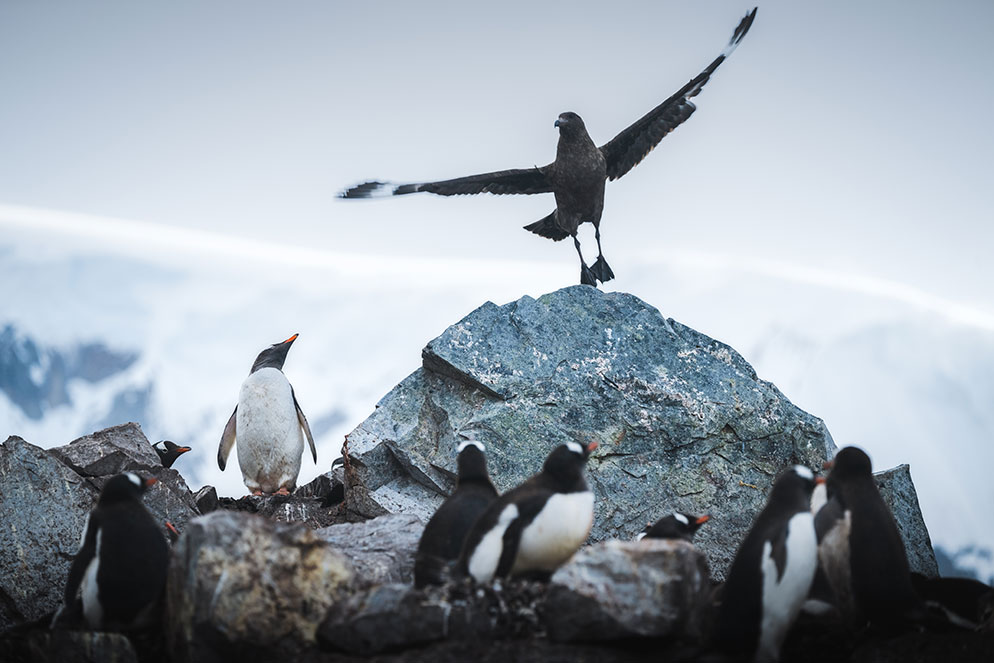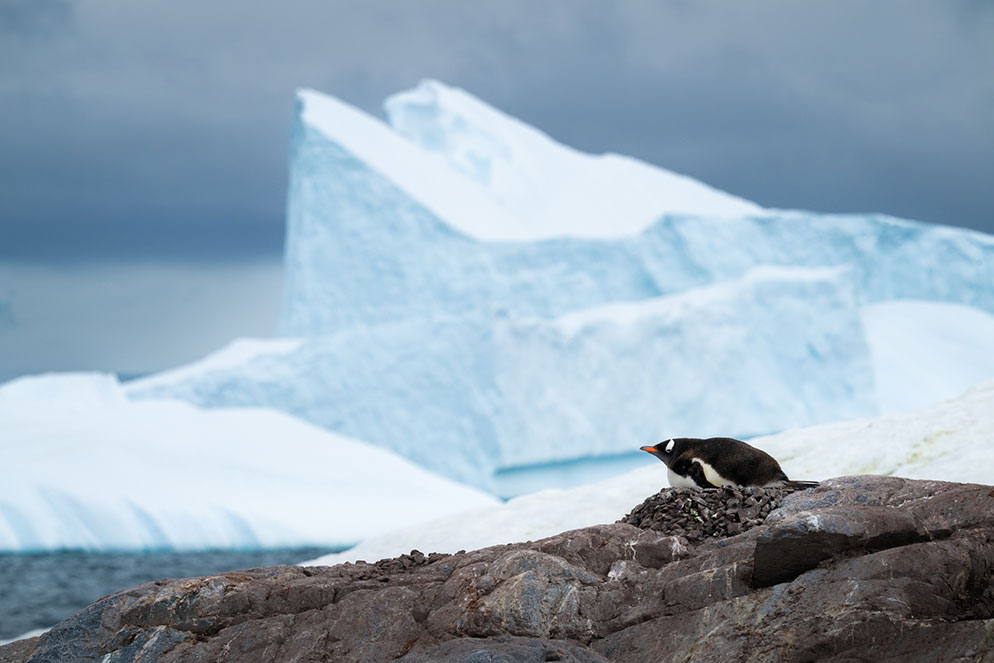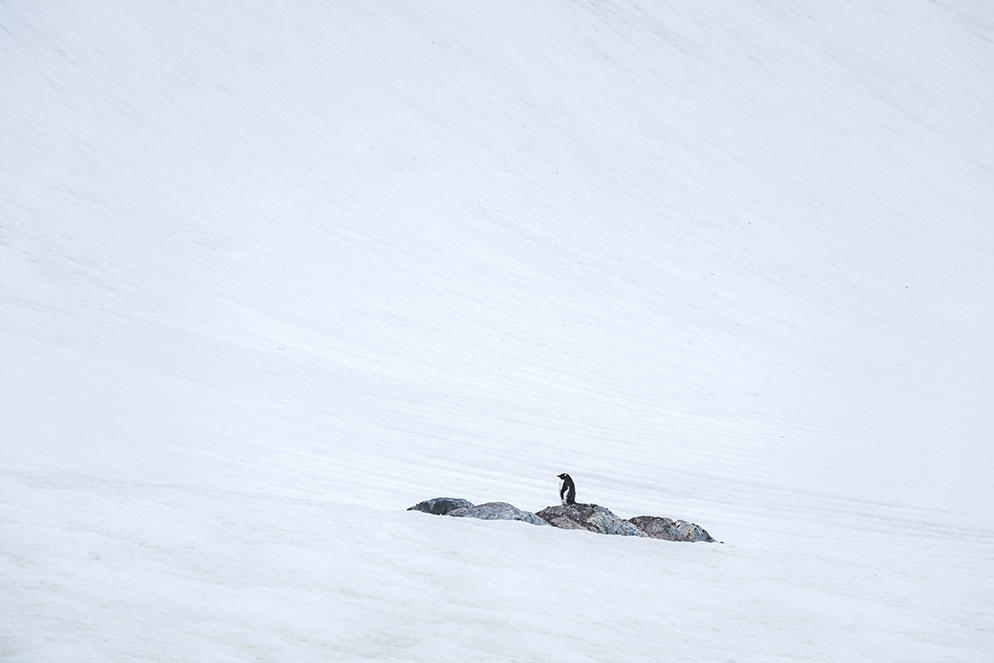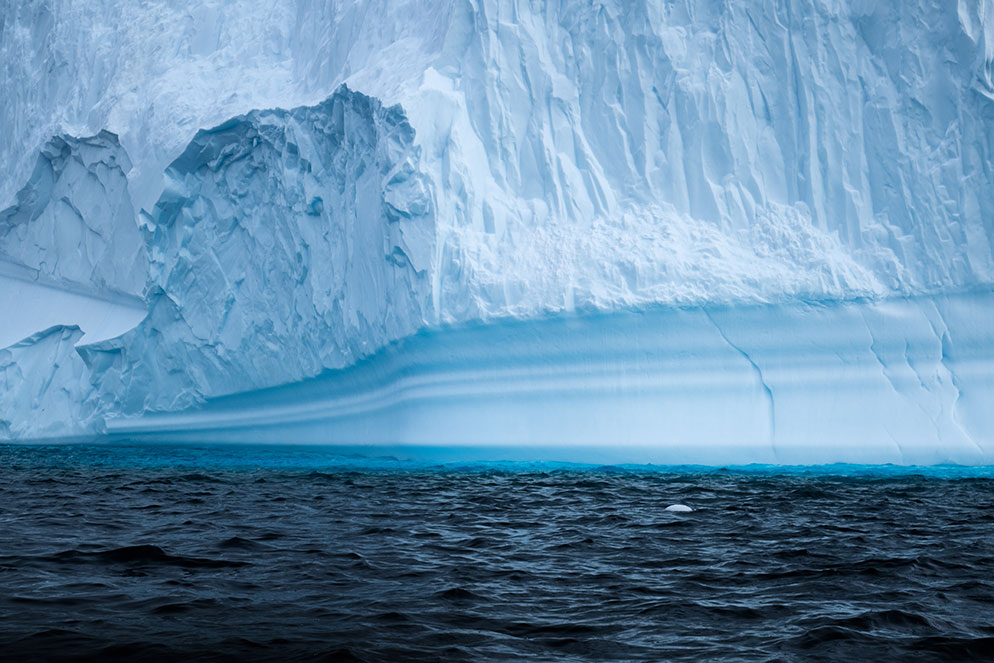Under Pressure: An Antarctic Field Test for a Photographer and his Z 9
A Quick Peck. Taylor Gray’s first Antarctica adventure photographs were taken not on the continent, but on South Georgia Island. “These two king penguins will stay together for the mating cycle, taking turns caring for the egg. Here they’re greeting each other after one has returned from fishing.” Z 9, NIKKOR Z 100-400mm f/4.5-5.6 VR S, 1/400 second, f/11, ISO 500, manual exposure.
It’s said that your first visit to Antarctica is all about the penguins; then you’re drawn back for the ice. In fact, it was said to us by Taylor Gray, an outdoor and nature photographer/videographer who traveled to Antarctica prepared for both subjects, with maybe the scale weighted a bit toward the wildlife.
Problem is, Antarctic weather and terrain has a way of putting the pressure on visitors’ goals, especially those with a photographic project in mind. After two days photographing in South Georgia Island, Taylor lost a day to weather and had only four “very busy” days on the Antarctic continent instead of the five he’d anticipated.
Mating Call. A male king penguin on South Georgia stretches his head upward to become as tall as possible and gives a trumpeting call to attract a female, who’ll judge his suitability to be her monogamous partner until their egg is hatched. Z 9, NIKKOR Z 100-400mm f/4.5-5.6 VR S, 1/1250 second, f/5, ISO 400, manual exposure.
Fortunately, Taylor had a lot going for him. There’s his uncanny ability to create storytelling images that capture the emotion of the moment, whether conveyed in one of his masterfully edited videos or in compelling single frames. He’s also a quick, intuitive shooter when the circumstances demand it; a thoughtful, patient one when time permits.
And he had with him on this adventure the extraordinarily capable Z 9, which provided features made for superb video and still images and a rugged build more than up to the challenge of the environment.
Valley of Kings. “On South Georgia, the king penguin colonies steal the show,” Taylor says. “It was an emotional arrival, what with 140,000 king penguins estimated at the landing site.” To get a tack-sharp image that captured both scale and detail, Taylor used focus shift to take three images, each at a different focus point, then stacked them in post-production. Z 9, NIKKOR Z 100-400mm f/4.5-5.6 VR S, 1/320 second, f/8, ISO 400, manual exposure.
Something Completely Different
The scenes and situations in Antarctica were unique to Taylor’s experience, even though he’s one of those photographers who seems constantly in a state of motion across the globe. “I’d heard Antarctica was the most alien environment you could imagine,” he says, “but I didn’t understand the scale of it until I was there: thousand-foot mountains rising out of the ocean, whales all around you, and seals, thousands of penguins and sea birds.”
He may have arrived short on expectations. In other words, pretty much the way he likes to work. Preserve a sense of wonder and reactions are spontaneous and real—but there’s always a purposeful narrative to his work. His basic idea for Antarctica was “to go for kind of a shock-and-awe of how incredible this place is in images of wildlife, landscapes and the raw ruggedness of it all.”
Takeoff. “You see life and death going on every day here,” Taylor says. In this image the struggle was between a predatory skua and fierce parent gentoo penguins. “The bird sits and observes, and if it sees a parent not paying attention to a chick, it takes off. The nearest penguin here gave the distress call. I shot 30 frames per second to catch this moment.” Z 9, NIKKOR Z 100-400mm f/4.5-5.6 VR S, 1/400 second, f/5.6, ISO 400, manual exposure.
First Watch. A gentoo parent guarding the nest. “The male will gift the female with the stones, and she will make the stone-circle nest on the rock. There’s a lot of competition for stones, and sometimes you see males go to nests and steal them for their mates.” Z 9, NIKKOR Z 100-400mm f/4.5-5.6 VR S, 1/400 second, f/11, ISO 800, manual exposure.
The trick is not to be overcome by it. When you’re seeing thousands of penguins stretching to the horizon, there’s got to be an element of, How do I do this? “Especially since I’d lost a day, there was limited time to have all well-thought-out shots,” he says. “There were times when it was very much run-and-gun shooting, but there were also times when I'd come across scenes—especially of wildlife interactions—and it’s, Okay, this is special, I’m going to slow down and take some time to really watch this to see how it unfolds.”
Neighborhood Menace. “This is a pretty close shot of a predator skua. There’s a rule in Antarctica that you can’t approach wildlife closer than 15 feet, but the wildlife didn’t seem to get the memo. A lot of times their curiosity seems to override whatever fear they might have. They can get quite close if you stand still enough, which was the case here. It walked up and as it was vocalizing I was able to get a really good look inside its mouth.” Z 9, NIKKOR Z 100-400mm f/4.5-5.6 VR S, 1/250 second, f/5.6, ISO 500, manual exposure.
One of those times was the instance of a skua, a predatory sea bird, threatening gentoo penguin chicks. Taylor captured it in both stills and video. “That was a special experience—one of those moments when you have to slow down, observe it through the viewfinder and get your shots, but at the same time take it in and appreciate what you’re watching.”
The common factor of Taylor’s video and still-image storytelling in Antarctica was quick recognition of situations like the skua attack that are offered in a beautiful, pristine wilderness where it’s possible to observe wildlife in its most natural and raw form. “Unlike animals living around human populations, in Antarctica the penguins, seals and sea birds are pretty much fearless,” Taylor says. “They go about their business and couldn’t care less about your presence. It was really cool to be a quiet observer of how wildlife interact with each other.”
Patience. “I’ve always enjoyed creating minimalistic images, but could I do that here, on Cuverville Island, in the Errera Channel, and still get a sense of scale? This lone gentoo is molting its old feathers—standing in the wind until they’re gone, a process that can take up to three weeks.” Z 9, NIKKOR Z 100-400mm f/4.5-5.6 VR S, 1/250 second, f/5.6, ISO 800, manual exposure.
There were times I really had to push the weather-sealing on the Z 9 a pretty fair amount, but everything held up beautifully.
Embrace. The Antarctic provides minimalism in this photo as well. “Despite the cuddly appearance, Antarctic fur seals are pretty aggressive,” Taylor says, “and this is really a story of showmanship between two juvenile males. The background—the face of a glacier with beautiful blue hues—provided some contrast.” Z 9, NIKKOR Z 100-400mm f/4.5-5.6 VR S, f/5.6, ISO 1000, manual exposure.
Tech Support
The Antarctica project was Taylor’s first shoot with the Z 9, but with long-time experience using Nikon professional-level gear, he had confidence in the camera’s capabilities, and its toughness. “When you come ashore with anything electronic, you don’t want to mess with salt water,” he says, “so I was really, really careful. After that, the weather is going to get to you. There was a lot of rain—everything got wet really fast.” He had a cover on the camera, but, as he says, “There’s only so much they can take. There were times I really had to push the weather-sealing on the Z 9 a pretty fair amount, but everything held up beautifully.”
As important as the camera’s features and rugged build were to the project, so were the NIKKOR Z lenses he used—the 14-24mm f/2.8, 24-70mm f/2.8 and 100-400mm f/4.5-5.6 VR—and the Z Teleconverter TC-1.4x. “In an environment as large as this, I tended to use the medium focal length to capture wildlife in their environment, but I shot with the long lens most of the time and was able to use its 100mm length to capture a kind of intimate perspective on the wildlife and also include a lot of their environment in the frame.”
Glacial Blue. “Each iceberg has a different size, texture and shape, and each is constantly changing—calving, breaking apart, melting—so each is a piece of art in itself. Lines in the ice texture represent layers of snow that were exposed to the Antarctic summer; then another layer was added and compressed. The horizontal lines at the bottom are a pattern carved out by erosion.” Z 9, NIKKOR Z 24-70mm f/2.8 S, 1/400 second, f/8, ISO 400, manual exposure.
Striation. “Textures and lines make each iceberg unique. The diagonals here mean that a piece broke off, causing the iceberg to shift, so lines that were once level are now angled to the water.” Z 9, NIKKOR Z 100-400mm f/4.5-5.6 VR S, 1/640 second, f/9, ISO 200, manual exposure.
For Taylor the storytelling aspect of imaging, whether in stills or video is similar save for one challenging difference: with stills he could take any number of images and present them however he liked. With video, he had to convey the scope of what he was seeing in a two-to-three-minute edit. The answer was to go for the graphic emotional moments and slow things down to capture details and highlight drama. “I used a variety of frame rates for slow motion depending on the subject,” he says. “Most of the landscape footage—there’s not much action to it—was 30 fps, which is kind of the basis of the entire film. But for the scenes of the gentoo penguin defending its nest from the skua, I really took advantage of the Z 9’s 4K 120 fps to really slow down the motion.”
What increases the drama of that situation is Taylor’s editing decision. He shot the penguin’s defense in two takes and was able to get different perspectives at different focal lengths. The edit cuts away from the action at certain point, only to return to make the needed emotional connection for the viewer.
Sweet Dreams. “A sleeping Weddell seal—you can see him snorting and exhaling in the video. I really like to get to eye level or lower with subjects.” Z 9, NIKKOR Z 100-400mm f/4.5-5.6 VR S, 1/640 second, f/8, ISO 400, manual exposure.
Journey of Discovery
“I learned a whole lot down there,” Taylor says of the Antarctic project, and maybe the most important thing was to use his skills and experience in a place that’s borderline overwhelming. “Initially when I arrive at a particular site, I tend to overshoot,” he says. “It’s almost as if I don’t have time to even think about it.” In Antarctica, knowing he was short a day, he had to get over the initial adrenalin rush and take control of the situation. “Once past that phase, I was able to think a little more carefully about how I wanted to capture what I was seeing.”
Water + Stone. At Portal Point, on the Antarctic Peninsula, Taylor had the time to plan a long exposure. “The idea was to capture the milkiness of the water against the weathered rocks, and in the mid-distance, water moving around chunks of ice. It looks like a calm day but there’s actually a tumultuous swell coming ashore. There’s brighter blue, almost Caribbean-looking water in the midst of this rugged place, and that’s also what I wanted to combine and contrast.” Z 9, NIKKOR Z 24-70mm f/2.8 S, 6 seconds, f/16, ISO 32, manual exposure.
He also learned that the Z 9 will be his workhorse camera going forward. He mentions the ability to switch quickly and easily between still and video shooting, something he could do with his Z 6, but now he’ll have “more megapixels to work with for stills and higher frame rates for video.”
He also appreciates the ability to shoot at ISO 64—“great for landscape photography”—and with the Z 9’s expanded ISO range he can get down to ISO 32 for long exposures. “In Antarctica the Z 9 became my all-in-one tool for any project I need to tackle,” he says. “There are no limitations.”
Over the Horizon - Taylor Gray’s stunning video tracks the storyline of his journey from awestruck observer to forever-changed witness to the beauty, struggle and ultimate fragility of the Antarctic.

